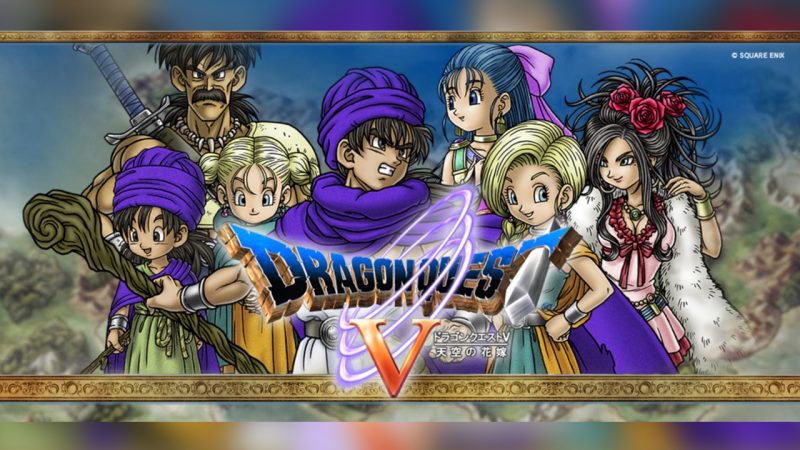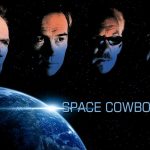Is it Dragon Quest or Dragon Warrior? Yes!
Well, I’ve done it. I’ve completed the first game on my Twitch stream: Dragon Quest V – The Hand of the Heavenly Bride. Let me tell you, this game is incredible. It’s a masterpiece of storytelling in this medium. In all truth, it’s damn near perfect. I can keep gushing, but I’ll try to remain detached.
I played this game only once before I started it on my stream, but it was a different version. The only release the US has ever gotten of this game came out in 2009 on the Nintendo DS. The original release (that I played for the stream) was on the SNES back in 1992. Even with my lack of experience with Dragon Quest V, it was obvious to me that it’s one of my all-time favorites – currently, it holds the #5 spot on my list of top 25 games of all time. This last playthrough only served to solidify that position for me.
Below I’ll go through the mechanics that make this game special, its narrative structure as a whole, and I’ve done my best to identify 3 major elements that it did right, as well as 3 elements that it did wrong. That last, by the way, was not an easy task. But, I think I managed well enough. For clarity, I will follow a few conventions when discussing this game:
I always name the protagonist of Dragon Quest games “Edrick”, and so he will be known below.
The first instance of a character, spell or place name will be its SNES fan-translation. I will include the DS re-translation version of the name in parentheses.
Please note that there may be SPOILERS for anyone who hasn’t played this yet. It’s not my intention to ruin anything for you, but that’s just the nature of an analysis of the narrative structure. Beware.
Mechanics
In general, there are some mechanical throughlines that make each new Dragon Quest installment familiar to anyone who’s played the previous games. Musical themes, the menu system and several items and pieces of equipment exist in essentially all of the entries in the series. These consistent elements manage to create a sense of familiarity without being overly repetitive, almost like a bare-bones template that defines the look, feel and world of the new game, that the developers can use to build a fantastic new experience. As a result, each game is able to introduce new elements that drastically change each game while still maintaining a link to the ones before it. So let’s get down to it:
Monsters in Your Party
Like some previous Dragon Quest games, Dragon Quest V has more party members than you can actually have on the front lines in battle. Unlike any previous games, these party members can be monsters you’ve recruited during a battle. This is great! Who doesn’t want a King Cureslime or Metal Babble in the party?
The only problem, I think, is that it can take something like 8 hours of grinding to get a King Cureslime. And there’s nothing the player can do to increase the chances of recruiting a monster. For any battle where a recruitable monster is the last enemy killed, it has a set chance to join the party. In the case of a minor monster like a Brownie, that might be 1/8. In the case of a King Cureslime, it’s 1/64. Outside of a cheat, there’s no way around it. Just grind and grind and grind and eventually, maybe, one will join.
It could be much worse, of course. Having a random monster from any given fight join you would mean you couldn’t selectively try to recruit a King Cureslime or whatever it is you’re wanting to get. Or, they could all have a 1/64 (or worse) chance to join, instead of each monster type having its own probability. I am definitely thankful neither of these is the case, but that doesn’t mean it’s perfect as-is.
Some of these monsters are incredible in your party. I have a personal affinity for the slime-type monsters so my 3 most heavily-used party members were a regular Cureslime, a Slime Knight, and the King Cureslime. The level of support abilities and just raw statistical strength offered by these monster allies really makes for a well-balanced party no matter how strong your human characters are. Other play styles will be similarly well-complemented by other monsters, so you can go through the game however you’d like without having to worry about not having enough healing, or enough defense, or whatever the case may be.
The Hero’s Family
I love the family. There’s maybe not enough customization of their abilities, but I think overall this is a great way to get the player a little more invested in the party. Both times through, I chose the more magic-heavy wife. She’s not the canonical answer, or the most obvious if you’re following the story, but whatever, I’m a sucker for blue hair and magic.
Turns out I didn’t even really use the wife in the party. By the time she joined permanently, there was just too much leveling to do to get her caught up. Coupled with the party being limited to 3 characters in a battle, that meant my front-line was usually Edrick and the children. Or a King Cureslime, because damn.
Aside from all of that, there are some incredible narrative moments that involve the family, including Edrick’s parents. I’ll go into this a little more under What They Did Right, but suffice it to say, the family dynamic really works in this game.
Zoom and Wings of Wyvern
This is a minor point, but still a nice change. In most Dragon Quest games, the spell Zoom (Return) and an item called the Wings of Wyvern are essentially the same thing. They allow you to fast-travel to a previously-visited town (usually one with a Priest, though I’ve never nailed down exactly what makes a place Zoom-able).
In Dragon Quest V, the Wings item returns you to the last place you visited, while Zoom lets you choose from a list. What’s more, Zoom is obtained as part of a story element, rather than being learned automatically by leveling. As far as I am aware, it is not required to complete the game.
The Narrative Structure
BEWARE, SPOILERS ABOUND
Dragon Quest V is broadly separated into 3 generations of play. Edrick begins as a child, following his father on a quest to find the Legendary Hero. After some minor misadventures on his own, Edrick’s father, Papas (Pankraz), is violently killed. The young child Edrick and his friend Prince Harry of Reinhart (Coburg) are sent into a decade of slavery.
The action picks up when Edrick and Harry are teenagers, attempting escape from captivity. Here begins the search for Edrick’s mother Martha (Mada), who he believes is still alive somewhere in the world. This generation ends with Edrick and his wife being turned into stone statues and sold for display as art.
After 8 long years as a statue, two children approach and remove Edrick’s curse. The now-reunited three-quarters family embarks on a quest to find their wife and mother, ultimately discovering on the way that Edrick’s son is the Legendary Hero that Papas was searching for all along!
Look, I’m sorry for the book report, but I needed to illustrate the structure so I could talk about it. I have some things to point out about it. First, it allows for spectacular pacing. The first generation is short, and mostly a tutorial for combat, dungeons and exploration. There is a solid bit of story that you can accomplish early, and the section ends. No long, drawn out goals out in the distance, that bit comes later. It serves to get the player hooked immediately, and it is an exceptional feature of this story.
The generational transitions are some of the best storytelling in the genre. While Dragon Quest IV is probably my favorite of all of these (and ranked #3 on the afforementioned list), it lacks this kind of player engagement. Dragon Quest IV’s Edrick is a blank slate for the player’s imprint. This Edrick is a fully-fledged character with goals that are personal and touching.
SPOILERS ARE MOSTLY OVER BUT DON’T TAKE MY WORD FOR IT
What They Did Right
I’m going to endeavor in this and all future reviews to share a brief list of the major successes and failures of the game. Successes abound in this particular title, while failures were hard to come by, but here goes:
Story
Like I said above, the story is a home run. You care deeply about Edrick, and his family, and desperately want revenge on Mildrath (Nimzo) for what he’s done. I can’t really go too far into the story here without spoiling too much, but it is probably better in all technical senses than all but 2 games in history.
Music
The returning musical themes are very welcome in this game, especially considering how much it strays from the standard formula for a Dragon Quest title. The battle, overworld, tower and dungeon themes are all at or near the top of their respective classes in the series, and the Dragon Quest fanfare’s debut late in the story comes as a genuine delight.
Characters
Also as I’ve touched on already, the characters have meaning in this game in a way that no previous Dragon Quest game could muster. Edrick, the wife (there are 2 or 3 choices for the wife, depending on your system), and the children are compelling, and the Martha (Mada) and Papas arc is heartbreaking. Round that out with some non-family members like Sancho, Pippin (Tuppence) and Borongo (Sabre), and you’ve got a cast that has a little bit for everyone. This is, of course, to say nothing of the monsters.
What They Did Wrong
The Teeny Tiny Party
The SNES version of this game (on which this review is based) allows only 3 active party members, and that’s a little frustrating. I was genuinely upset that I could not have the entire family in a fight, and honestly expected that the final battle would change the game up and allow it for the purposes of storytelling. As it stands, this didn’t exactly make the game any harder than it was before, but I felt that each party member filled a role well, and I wanted them all to fight.
The Casino
Poker from Dragon Quest IV is my casino game of choice. I was a little upset to see that it was missing from Dragon Quest V. Coupled with the fact that I probably only bought 3 items from the Casino, I don’t really see the point here. Where are my Meteorite Armbands? Where are my Metal Babble Shields? A shame.
Monsters in Your Party
Monster recruiting essentially ends once you get the family together. With a few exceptions (the King Cureslime is a prime example), the family members are stronger. Couple that with the issues I raised above, and I think this could definitely be improved.
In Conclusion
Final Thoughts
To conclude, this is a must-play game for any fan of the genre. The standard Dragon Quest menu system may be a little cumbersome for players who are unfamiliar with the series, but the interface improvements afforded by the 4-button SNES controller layout will alleviate most of the major issues. This game has humor, and drama, and action; it has heroic heroes and villainous villains and its fair share of tense, painful action.
A friend of mine, unrelated to this blog, is about to play the DS version for the first time. As a huge fan of Dragon Quest IV himself, I can hardly envy him more the chance to experience this game fresh. I expect there will be an update with some of his thoughts to follow, when he’s done.
Some Stats
Rating: 9.5/10
Rank (All-Time, All-Genre): #5
Rank (jRPG): #4



